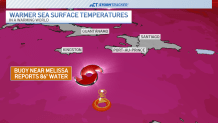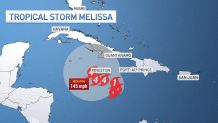Real-time data shows the water temperatures underneath Tropical Storm Melissa are 600 times more likely due to climate change.

The analysis is operated by Climate Central, a nonprofit organization that focuses on the science and communication behind climate change.
The organization compares current sea surface temperatures to average, then overlays the current and forecast track of tropical systems.
Melissa is currently a tropical storm southeast of Jamaica and southwest of Haiti. The storm will move over very warm water, around 86 degrees Fahrenheit, and that warm water will be a key piece of the storm’s rapid intensification.

Melissa is predicted to rapidly intensify from a tropical storm Friday night, to a major hurricane by Sunday night. Meanwhile, the storm will be drifting toward Jamaica, bringing storm surge, flooding and mudslides.

It is estimated that the ocean absorbs about 90% of Earth’s excess heat in its lower atmosphere. Warmer water means more fuel for hurricanes, as tropical systems grow stronger with warmer water.
The storms also grow wetter, evaporating and condensing more water from the ocean, to later deliver that water in the form of heavy rainfall.
Melissa is forecast to move through Cuba next week, and then out to sea. It will bear watching the next several days.
